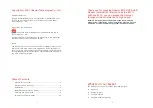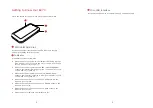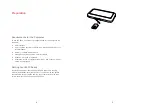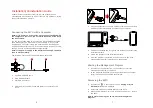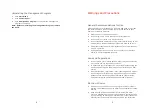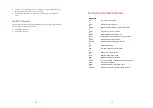
12
requirements. The following approvals and notices apply in specific
regions as noted.
CE Approval (European Union)
The wireless device is approved to be used in the member states of
the EU. Huawei declares that the wireless device is in compliance with
the essential requirements and other relevant provisions of the Radio
and Telecommunications Terminal Equipment Directive 1999/5/EC
(R&TTE Directive).
Radio Frequency Exposure Warning
For your convenience, Huawei has provided two USB cables for this
equipment and in order to comply with RF Exposure requirements,
this device should be mounted or used in such a fashion that the
transmitter is more than 20 cm away from all persons at all times.
* The general public RF exposure limits referenced in the R&TTE
Directive are consistent with the published Guidelines of the
International Commission on Non-Ionizing Radiation Protection
(ICNIRP) 1998. ICNIRP is a formally recognized non-governmental
organization in Non-Ionising Radiation Protection for the World Health
Organisation (WHO), the International Labour Organisation (ILO) and
the European Union (EU). For more information, visit the ICNIRP
website at www.icnirp.de.
Certification Information (SAR)
THIS DEVICE MEETS THE GOVERNMENT'S REQUIREMENTS FOR
EXPOSURE TO RADIO FREQUENCY ELECTROMAGNETIC FIELD.
Your wireless device is a low-power radio transmitter and receiver.
When it is running, it emits low levels of radio frequency energy (also
known as radio waves or radio frequency fields).
Governments around the world have adopted comprehensive
international safety guidelines, developed by scientific organizations,
e.g. ICNIRP (International Commission on Non-Ionizing Radiation
Protection) and IEEE (Institute of Electrical and Electronics Engineers
Inc.), through periodic and thorough evaluation of scientific studies.
These guidelines establish permitted levels of radio wave exposure
for the public. The levels include a safety margin designed to assure
the safety of all persons, regardless of age and health, and to account
for any variations in measurements.
Specific Absorption Rate (SAR) is the unit of measurement for the
amount of radio frequency energy absorbed by the body when you
use a wireless device. The SAR value is determined at the highest
13
certified power level in laboratory conditions, but the actual SAR level
of the wireless device while operating can be well below the value.
This is because the wireless device is designed to use the minimum
power required to reach the network.
All models of Huawei's wireless device are designed to meet radio
frequency exposure guidelines such as European Council
Recommendation and Federal Communications Commission Notice
(United States).
European Council Recommendation: Before a wireless device
model is available for sale to the public, it must be tested according to
the technical standard-EN 50361 and not exceed the limit established
by the European Council Recommendation: 1999/519/EC for safe
exposure.
The SAR limit adopted by the 1999/519/EC is 2.0 watts/kilogram
(W/kg) averaged over ten gram of tissue. The highest SAR value for
this device type when tested is 0.413 W/kg.
[EN 50361 scope states "This basic standard applies to any
electromagnetic field (EM) transmitting devices intended to be used
with the radiating part of the equipment in close proximity to the
human ear including mobile phones, cordless phones, etc. The
frequency range is 300 MHz to 3 GHz. Therefore, the above text does
not address primary use of the wireless device product.]
FCC Statement
This device complies with Part 15 of the FCC Rules. Operation is
subject to the following two conditions: (1) this device may not cause
harmful interference, and (2) this device must accept any
interference received, including interference that may cause
undesired operation.
Class B Digital Device
This equipment has been tested and found to comply with the limits
for a Class B digital device, pursuant to Part 15 of the FCC Rules.
These limits are designed to provide reasonable protection against
harmful interference in a residential installation. This equipment
generates, uses and can radiate radio frequency energy and, if not
installed and used in accordance with the instructions, may cause
harmful interference to radio communications. However, there is no
guarantee that interference will not occur in a particular installation.
If this equipment does cause harmful interference to radio or
television reception, which can be determined by turning the
equipment off and on, the user is encouraged to try to correct the
interference by one or more of the following measures:
Reorient or relocate the receiving antenna.
Increase the separation between the equipment and receiver.

